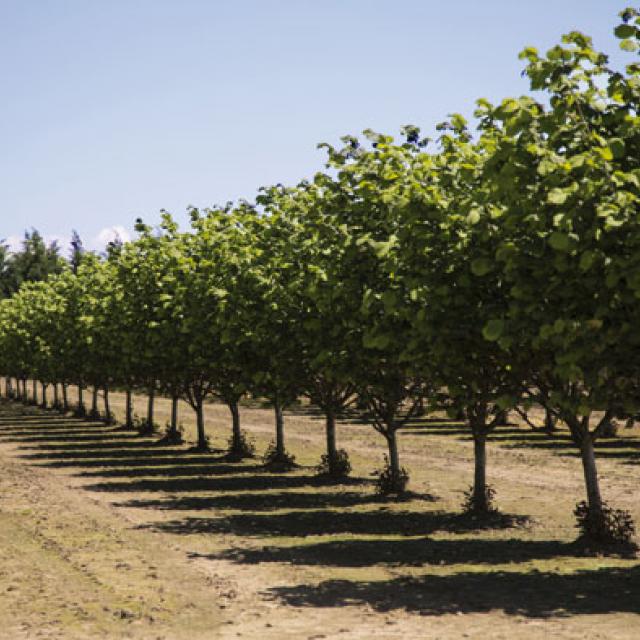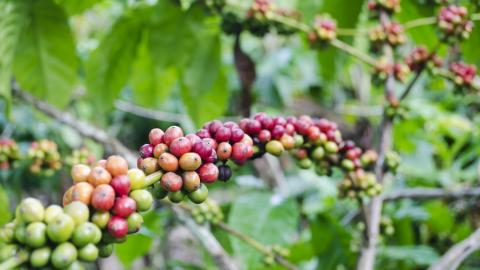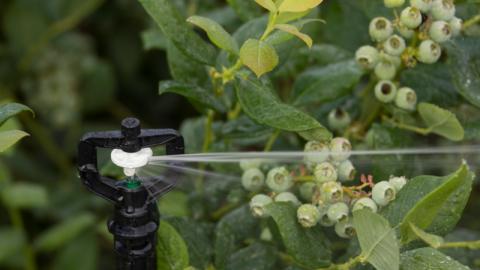Although most orchards in France are experiencing growing international competition, nut production is booming. For some years now in France, there has been an increase in the surface area put down to walnut and hazelnut orchards in the great river basins of the south-east and south-west, where most of the nuts are produced.

With an average annual yield of 38,000 tonnes produced on more than 20,000 hectares, the walnut is the second most cultivated orchard crop in France in terms of surface area, behind apples in first place and above plum trees in third. The French walnut industry has succeeded in protecting its market, both at national and international level, by promoting the quality and identity of the nut. This success has translated into the creation of two controlled designation of origin labels for walnuts.
The production of French hazelnuts is very regiona-lised, with the key areas being the Lot-et-Garonne department in Aquitaine and to a lesser extent in the Midi-Pyrénées region. With an annual production of 8,000 tonnes, the French sector is ranked number 7 in the world, a long way behind Turkey and Italy. However, hazelnut prices have reached a very attractive level for producers in the light of a drop in production in Turkey and the growing demand of leading manufacturers, such as Ferrero. Hazelnut orchards have, therefore, maintained a dynamic approach mainly due to the support of the Unicoque cooperative, which markets 98% of national production, making the French sector one of the most successful in the world. Today, there are more than 300 hectares of hazelnut plantations established each year.
Walnut orchards: will irrigation provide an insurance against the lean years?
The walnut orchards do not produce optimum yields.
The pattern of high and low yields in alternating years is a very common phenomenon with walnut orchards, the average yield fluctuating between 1.5 and 3.5 onnes per hectare. This could be explained by both climatic and physiological factors. In certain countries, such as the United States, these parameters are often controlled and the yield is optimised with no great fluctuations. Although there are many factors, two in particular explain this phenomenon: the ageing of the orchard and the relatively low adoption rate of irrigation for the crop.
In fact, a significant number of these orchards are of the traditional type that have been established for several generations. The trees are not dug up and remove, even when production is low. The price of walnuts today ensures that the producers obtain a reasonable income, without resorting to irrigation in certain pedoclimatic situations. Clémence Bazus, a technician with the cooperative Coopenoix, located at Vinay within the CDO walnut region of Grenoble, confirms this situation and rather hopes that the industry will take advantage of these prosperous times to invest in the long term. Throughout France as a whole, 60% of walnut orchards are still not irrigated. And among the orchards that are irrigated, barely a third of them are equipped with micro-irrigation systems.
Why irrigate walnut orchards?
The walnut orchards are often not grown very intensively, with minimum amounts of inputs being used - although the problems linked to the walnut husk fly and leaf spot disease (caused by colletotrichum) tend to change this situation - and the quality of the shelled walnuts is more than satisfactory. However, Franck Michel, who is also a technician with Coopernoix, and his colleague, defend irrigation because it constitutes an insurance against often unpredictable climatic conditions. After the dry season of 2016, certain producers experienced difficulties: the early leaf fall harmed the yield and plant water stress during the filling-out stage affected the quality of the developing kernel.
The direct impact of plant water stress on the different growing stages of the walnut has been summarised by the CTIFL.
Unlike most orchards, pruning and thinning-out cannot be used as techniques for controlling plant growth. In the event of a prolonged deficit, the consequences for the productivity of the nut can last for 4 or 5 years. SENuRA - an experimental walnut producing station in the Rhône-Alpes region - summarises the benefits of irrigating walnuts in three key points:
• Increasing and standardising the production process
• Guaranteeing fruit quality
• Compensating for the competition for the resources posed by the grass cover
What system to choose?
Among the irrigated orchards, we find many types of installations nowadays: irrigation with impact sprinklers, mini-sprinklers, micro-sprinklers and, finally, drip irrigation.
Whereas irrigation with impact sprinklers is easy to learn and does not require any maintenance, there are quite a few disadvantages: the required infrastructure is sizeable, expensive and even cumbersome, the dimensions of the pipes and hydraulic equipment must have high pressures and flow rates. This kind of sprinkler system can also lead to soil compaction and it is not adaptable to sloping terrain. For producers who wish to maintain a full coverage irrigation system while limiting the negative aspects, NETAFIM offers an alternative so-called micro-sprinkler system - named after the fine droplet size - with the product Meganet.
However, these so-called micro-irrigation systems, including micro-sprinkling and drip irrigation, are recommended by NETAFIM for walnut orchards. There are three main reasons:
• Less water resources required: the required flow rates and operating pressures are considerably lower
• Efficient applications: the wetted surface is reduced and there is greater irrigation frequency, allowing for water to be applied to the roots where the tree needs the water in real time.
• No mechanical constraints: pendulum-type
micro-sprinklers and subsurface drip irrigation systems are not damaged by passing farm machinery.
On the other hand, these systems require a finer filtration mesh and regular maintenance. It is recommended that a technician should be consulted for carrying out a preliminary study of the irrigation network.
IT IS WORTH NOTING that drip irrigation can also be installed on the surface. Even though it is more restrictive, this solution can be used in situations where there are very limited water resources
The choice between micro-sprinkler and drip irrigation depends on the priorities and constraints of the farmer: soil type, desire to « fertigate » (applying fertilisers in liquid or a dissolved form directly by drip irrigation) or even his or her capacity to invest.
Hazelnut orchards: is this an industry at the forefront of irrigation technology?
The French walnut industry is structured around its main player: the Unicoque cooperative located at Cancom in the Lot-et-Garonne region, which accounts for 98% of the production. The cooperative has an ambitious plan to triple the volume of production between now and 2030, by supporting the planting of 300 to 400 hectares per year; in particular, this will be achieved by implementing funding solutions that assist the producers at the time of the initial investment.
Irrigation occupies a central role in the production of French hazelnuts
Unicoque stipulates that all its hazelnut-producing members should set up an irrigation system on their orchard. From data gathered in the field, every three days during periods of peak water consumption the technicians pass on their recommendations for irrigation: the recommendation relate to variety, age of the orchard, type of irrigation and even regional variations. The average yield of the orchards of the grand Sud-Ouest region easily reaches 3 tonnes per hectare because of increased control over pruning techniques. This high level of productivity, with mechanised harvesting leading to a low labour costs, has made the French walnut industry one of the most competitive in the world. More than being just a guarantee, irrigation has now become a veritable performance tool for the orchards, allowing for the optimisation and uniformization of the nuts produced.
What system to choose?
Nowadays, hazelnut orchards are equipped with micro-sprinklers and above-ground and subsurface drip irrigation systems.
Whatever the system, Unicoque recommends that the system should have the capacity to apply 45 litres per tree per day, giving an average application for the season of 50 to 200 mm. Following studies carried out between 2003 and 2010 by specialist technicians on the optimisation of the amounts of water applied, Unicoque now recommends the installation of a two-line subsurface drip irrigation system, to be set up from the first year that the orchard is planted. At the present time, 70% of new installations have subsurface drip irrigation systems. The advantages are:
• The efficiency of the applications,
• Very simple maintenance and robustness of the system,
• The discretion of the system,
• The possibility of applying additional nutrients by fertigation,
• Compatibility with mechanised harvesting,
• The volume of wetted soil is the same as that of micro-sprinkling.
Some producers still
maintain their loyalty to micro-sprinkling for different reasons: soil type, old habits formed when producing plums or problems with the dust at harvest time.
TESTIMONY: PATRICK CHASSAC, a conservation arboriculture producer in the Lot-et-Garonne Region (plums and hazelnuts)
Patrick Chassac is one of the pioneers in the micro-irrigation of hazelnuts: having been equipped with a NETAFIM subsurface drip irrigation system for 15 years and he only has positive comments to make about the system:
• The hazelnut benefits from the water applications: subsurface drip irrigation maintains the soil moisture at a constant level. Unlike other orchards, hazelnuts do not require a succession of dry and wet periods to be able to juggle between plant growth and fruit quality.
• Water consumption has been reduced by 40% during the peak periods of the season: subsurface drip irrigation allows for the applications to be staggered from April until early-November with the same total amount applied.
• Productivity is more regular: the application of nutrients directly into the rooting zone helps the hazel nut tree overcome the phenomenon of one lean year followed by a year with a bumper harvest.
• No root intrusion for the hazelnut tree: unlike the plum tree, there has been no problem with root intrusion observed over the 15 years, despite the lack of preventive treatment.
Mr. Chassac schedules his irrigation with the help of soil sensors and he cannot see how he could possibly do without them.


